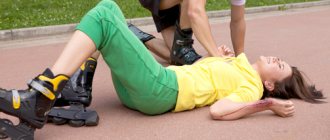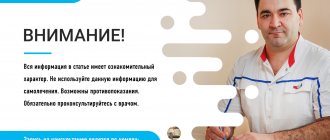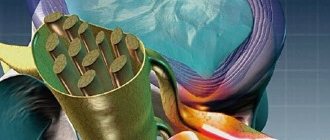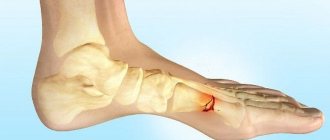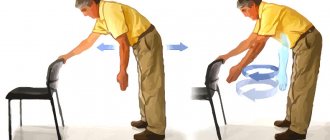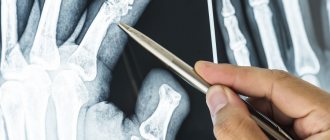Depending on the damage to the spinal cord, there are:
- fractures with spinal cord damage;
- spinal fractures without damage to the spinal cord.
Initial consultation with a rehabilitation specialist
+8
Record
By nature, spinal fractures are divided into:
- compression (as a result of vertical compression of the vertebral bodies;
- crushed (fragmented);
- combined compression-comminuted;
- fractures combined with dislocations (fracture-dislocations).
Mechanism of injury
From a physical point of view, a vertebral fracture occurs when the load on it begins to exceed its ability to withstand physical impact. This bone is most often affected by:
- car and other accidents (mostly cervical vertebrae are broken);
- falling from a height in a vertical position;
- being hit on the head with a heavy object;
- jumping into the water when diving (the neck most often suffers).
Depending on the mechanism of injury, the upper cervical vertebrae, the lower (80% of neck fractures), as well as the lumbar and lower thoracic vertebrae may be damaged (the upper thoracic is rarely affected).
Rehabilitation
As a rule, a fracture or fracture-dislocation of a vertebra is accompanied by a violation of the supporting function of the spine. Damage to the spinal cord, depending on the level of damage, leads to the development of tetraparesis (paralysis of the arms, torso, legs) with a fracture of the cervical spine or paraparesis (paralysis of the lower torso, legs) with a fracture of the thoracic and lumbar spine. Also, patients with spinal cord injuries often experience decreased or absent sensitivity below the injury site and impaired control of the pelvic organs (urination, defecation). Treatment tactics for a spinal fracture may vary. In case of an uncomplicated vertebral fracture without damage to the spinal cord and without disruption of the stability of the spinal column, conservative treatment can be carried out; in case of disturbance of the stability of the spine, a comminuted fracture, or damage to the spinal cord, surgery is indicated.
Rehabilitation of patients after a spinal fracture and spinal cord injury is one of the most difficult tasks for rehabilitation institutions. Timely, qualified rehabilitation assistance significantly improves the outcome of injury and increases the quality of life of the victim [Bedbrook G., 1979].
Get advice from a rehabilitation specialist or make an appointment
+8
Record
The main component of rehabilitation for spinal and spinal cord injuries is physical therapy (PT). Consistent and long-term use of exercise therapy methods and means allows for restoration or compensation of functions. Exercise therapy for a spinal fracture is not only a set of therapeutic gymnastics exercises. In order to achieve real results, individual lessons with an instructor and supervision by a rehabilitation specialist, regular training on simulators, adaptation of the cardiovascular system, and learning new movement skills are required.
The duration of rehabilitation after a spinal fracture ranges from several months to several years. It is absolutely not necessary to spend all this time in specialized rehabilitation hospitals. Much of the rehabilitation program can be completed at home.
The effectiveness and benefits of physical therapy
Evaluate effectiveness through the following tests:
- Measuring the time of holding the “swallow” position is an indicator of the correct functioning of the back muscles. If a person is able to hold out for 2 minutes in this position, this is a good result.
- Checking how long the patient can hold his legs at an angle of 45º - the work of the abdominal muscles is assessed. It is enough to hold the position for 2 minutes.
- Movement for 2 hours - the test is performed at the end of the third month of treatment. If there is no deterioration in your general condition, you can begin to sit down.
- X-ray examination - carried out at the end of the 4th month to assess the functions of the spinal column.
The benefits of physical therapy include normalizing the functioning of the cardiovascular system and stimulating nervous processes.
Regular exercise prevents the development of complications caused by a lying position, prevents muscle atrophy and activates metabolic processes. Gymnastics effectively stimulates performance, restores the elasticity and strength of the spinal column, helps restore muscle mobility, and normalizes the functioning of internal organs.
What procedures can be performed at home after a spinal fracture?
The following procedures can be performed at home:
- exercise therapy;
- Kinesiotherapy;
- Mechanotherapy;
- Massage;
- Certain types of physiotherapy (myostimulation, magnetic therapy, phototherapy);
- Occupational therapy;
- Classes with a psychologist;
- Consultations with specialists (surgeon, urologist, neurologist, rehabilitation specialist).
Occupational therapy
Kinesiotherapy
Photodynamic therapy (PDT)
Myostimulation (electrical stimulation)
The presence of bedsores, epicystostomy, catheter, tracheostomy is not a contraindication for rehabilitation at home.
Symptoms of vertebral compression fractures - diagnosis of such injuries
If the injury occurred as a result of an external force acting on the spine, the victim will immediately feel a sharp pain in the area of injury. This pain can be of a different nature - radiate to the limbs, be shooting, dull, increasing in intensity, tingling, etc.
If the damage has affected already pathologically altered vertebrae (for example, as a result of osteoporosis), then the symptoms of the injury may be erased or absent altogether, manifesting only temporary minor back pain and weakness. Such injuries very often go unnoticed and are recognized by chance, during diagnostic procedures for a completely different reason.
What are our advantages?
- More than 7 years of experience in outpatient rehabilitation;
- Necessary equipment for rehabilitation at home;
- Individual approach to each patient;
- Own training center for employees and relatives of patients and volunteers;
- Rehabilitation techniques recognized as effective throughout the world;
- We actively participate in the lives of our patients and support the volunteer movement.
Thanks to all this, we offer you a clear rehabilitation system with clear goals and objectives of treatment and joint monitoring of its results.
Clinical picture and complications of vertebral compression fracture
A compression fracture can be easily tolerated by the patient and practically not cause any unpleasant symptoms. In many cases, people are not even aware of the injury if it is minor.
However, in the future, in the absence of adequate treatment, the consequences of this damage can cause serious problems in the spinal column. In some cases, compression damage to the bone tissue of the spine can lead to very serious complications.
Complications of vertebral compression fractures:
1. Segmental instability is observed in the case of compression of the vertebral body by more than 50%. Spinal instability in this case is accompanied by severe pain and the inability to perform movements. In damaged bone tissue, degenerative changes quickly increase, nerve structures are compressed and damaged.
2. Pathological kyphotic deformity of the spinal column in the thoracic region occurs when its curvature exceeds 40-45 degrees according to Cobb. A hump is formed, visible visually upon examination. Most often, this complication is observed in elderly women with changes in bone tissue due to osteoporosis. Kyphotic deformity of the spinal column can be accompanied by prolonged and very severe pain, as well as muscle spasm.
Results of our work
- Woman
; - Age:
56 years old. - Diagnosis:
compression-ischemic myelopathy.
Patient with spinal fracture. Compression-ischemic myelopathy. At the time of admission, the skills of independent movement and positioning are absent. She cannot turn over in bed on her own and does not get out on her own. completely dependent on care. Video of getting up and taking the first steps after 2 months of treatment.
- Man
; - Age:
42 years. - Diagnosis:
spinal fracture.
Traditional treatment
Therapy for a compression fracture is aimed at eliminating pain , stimulating healing at the fracture sites, restoring muscle activity and normal functioning of the nerve roots. In some cases, surgical intervention is required to restore the vertebrae to their normal location and appearance.
Recovery takes about three months . During this period, the patient needs fixation and immobilization of the place where the fracture occurred, and restriction of the person’s movements.
Analgesic medications are used to help relieve pain. To enhance the effect, novocaine blockades can be prescribed, and in especially severe cases, drugs of the opioid group.
Among surgical measures, kyphoplasty and vertebroplasty , since they are considered the most minimally traumatic.
Correct therapeutic measures help restore the activity of the muscular system and the plasticity of the spine.
Video: “Compression fractures of the spine”
Periods of exercise therapy
The treatment complex for spinal compression fractures is divided into four stages of rehabilitation, each of which has a specific therapeutic task. Lack of consistency in going through all stages can lead to unexpected negative results. Each stage has been specifically designed based on a logical method for healing the spinal column.
Each stage is allowed to be completed at home. To do this, you will need fairly simple and affordable materials - a towel roller, a chair. Nevertheless, it is recommended to perform the first sessions together with a rehabilitation specialist, with the doctor providing assistance. Incorrectly done exercises will not only not bring benefits, but also cause harm. For example, when bending forward, sudden movements are not allowed.
The main goal of exercise therapy is a low load and a focus on performance. If pain occurs during the exercise, you must stop the exercise immediately and notify your doctor. He will determine the cause of the pain and correctly adjust the course of exercise therapy. The time of the lesson is also determined by the doctor.
First period
At the first stage of exercise therapy, the main goals are considered to be:
- restoration of general tone;
- restoration of blood flow and normal functioning of the circulatory system;
- restoration of breathing;
- activation of the functioning of the digestive tract;
- restoration of muscle tone.
The basis of exercise therapy at the 1st stage is considered to be exercises on breathing and the general development of the muscle system. Individual exercises last about 10 minutes and are performed up to 3 times a day. In this case, the position must be correct: the person is lying on his back on a hard couch. The head should be raised approximately 55 centimeters. Using special belts, the rehabilitation doctor performs longitudinal stretching of the spinal column. To remove the load from the deformed spinal column, a special gauze-cotton roller is placed under it. The set of classes includes the following exercises:
- The exercises begin with breathing through the diaphragm while holding a small bag of sand on your stomach.
- Hand development is carried out by squeezing and unclenching them at the elbows and fists.
- Perform movements with the feet in opposite directions.
- Straighten, spread your arms over the chest.
- Spread your legs apart without lifting them.
- Squeeze the body muscles for about 20 seconds.
- The lesson ends with a breathing exercise.
Second period
Starts after about 4 weeks. The task of the second period is to begin the restoration of the damaged muscular system, returning to its previous functioning. The load increases, becomes more complicated, and classes become longer. After 3 weeks, you are allowed to lie on your stomach. In this case, a cushion should be placed under the stomach to reduce the load.
- inhale and exhale, spreading and bringing your arms together;
- bend the upper limbs at the elbows, bringing them to the shoulder;
- flexion of the feet;
- move their arms away from the body, turn their head behind them;
- bend the lower limbs and pull them up in turn;
- breathing exercise.
Third period
The third period occurs between 45 and 60 days. Classes are aimed at strengthening the muscles of the entire torso. Coordination of spinal movement is restored. The load increases - classes are longer in time, and their density increases. To make a smooth transition to axial loading, exercises on the knees and all fours are introduced.
The following are added to the previous exercises:
- bend and straighten knees;
- lower limbs are moved to the sides;
- lying on the stomach, bend the upper limbs and make a deflection in the chest;
- on all fours, the lower limb is moved to the side, turning the head behind it.
The fourth period
During this period, the previous exercises are performed. An injured person is allowed to get up after about 45 days. Lifting is performed from a lying position; sitting down is strictly prohibited. At this time, exercises are included that are performed while standing.
- The upper limbs are bent at the elbows, using additional weights.
- The lower limbs are moved away from the body using resistance.
- Bend the lower limb at the knee and raise the pelvis using counteraction.
- While standing, roll from toe to heel and back.
- Sitting on your toes, strain your back, thigh and gluteal muscles.
Symptoms
In a child, compared to an adult, the formation of the spinal column is not complete, so the tissues and elements in it are more elastic. As a result, any symptom of pathology can be mild, which is why it is sometimes difficult to make a diagnosis.
After a child is injured, you should definitely consult a doctor if any of the following signs are present:
- Pain syndrome in the area of injury. As a rule, severe painful sensations appear within the first minutes after injury, then there is a gradual decrease in pain, which can increase during movement.
- Hematomas or bruises (the main sign of spinal damage).
- Limited movement, which occurs if the transverse processes of the vertebrae are damaged. In addition, pain may occur that radiates to the lower extremities when moving.
- General malaise in the form of dizziness, nausea and lethargy. These signs are evidence of a serious fracture involving nerve tissue.
- Pain syndrome in the abdominal area. Such symptoms appear when the affected vertebra is localized in the lumbar region of the spinal column.
- Limitations when moving the head. This symptom is characterized by injury to the spine in the neck and thoracic region.
- Feelings of pressure in the back. This sign indicates damage to the spinal tissue and nerve receptors.
Why does pathology occur?
The occurrence of a compression fracture is often noted in the lumbar region and rarely in the sternum. Injury to the lumbar region is caused by increased axial stress in this area, which occurs during a sharp bend, jump or fall.
The main sources of the problem are:
- Reduced strength of spinal tissues. In normal condition, the spinal column is able to cope with heavy physical load and the force impulse transmitted during impact. When the bone structure is weakened, fracture development is possible even with minimal stress.
- Presence of osteoporosis. Against the background of this pathology, bone mass decreases, as a result they weaken, and the risk of deformation due to stress increases.
- Lack of essential microelements. If the body does not have enough vitamins and minerals, it weakens, which affects the structure of the bones, which lose the ability to withstand stress.
- Increased mechanical impact. If a child falls from a height or puts excessive stress on the spinal column, the vertebrae may become deformed.
- Regarding the mechanism of injury, a fracture often occurs during a sharp buckle or an inaccurate fall.
Classification
Compression fractures of the spinal column are typically divided into three stages. A favorable prognosis is characterized by a stage 1 injury, in which the vertebra is deformed by a maximum of a third in height. In the second stage of damage in the area of compression, the elements of the spine are reduced by 1/2 in height.
In case of complex stage 3 injury, careful selection of therapeutic measures is required. A risky fracture is a comminuted injury, when fragmentation of the bone structure is observed, this causes disruption of the ligamentous tissue and a negative effect on the nervous system.
